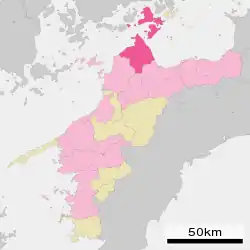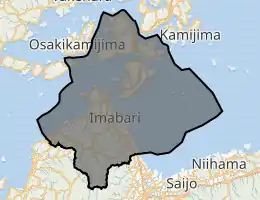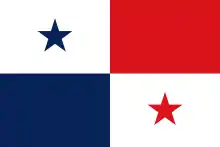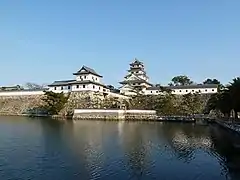Imabari, Ehime
Imabari (今治市, Imabari-shi) is a city in Ehime Prefecture, Japan. It is the second largest city in Ehime Prefecture.
Imabari
今治市 | |||||||||||
|---|---|---|---|---|---|---|---|---|---|---|---|
 View of Seto Inner Sea and downtown Imabari | |||||||||||
 Flag  Emblem | |||||||||||
 Location of Imabari in Ehime Prefecture | |||||||||||

| |||||||||||
 Imabari Location in Japan | |||||||||||
| Coordinates: 34°4′N 133°0′E | |||||||||||
| Country | Japan | ||||||||||
| Region | Shikoku | ||||||||||
| Prefecture | Ehime Prefecture | ||||||||||
| Government | |||||||||||
| • Mayor | Ryoji Kan (since February 2009) | ||||||||||
| Area | |||||||||||
| • Total | 419.56 km2 (161.99 sq mi) | ||||||||||
| Population (January 1, 2010) | |||||||||||
| • Total | 172,384 | ||||||||||
| • Density | 410.87/km2 (1,064.1/sq mi) | ||||||||||
| Time zone | UTC+09:00 (JST) | ||||||||||
| City hall address | 1-4-1 Bekku-chō, Imabari-shi, Ehime-ken 794-8511 | ||||||||||
| Website | www | ||||||||||
| |||||||||||
Following a recent merger, as of January 1, 2010, the city has an estimated population of 172,384 and population density of 410.87 persons per km². The total (merged) area is 419.56 km².
History
The area in which Imabari is situated had long been a strategic point for the control of the Seto Inland Sea. As a result, it was controlled by a variety of forces throughout the warring period, including a number of inland sea pirates. The city was officially founded on February 11, 1920.
On January 16, 2005, the towns of Hakata, Kamiura, Kikuma, Miyakubo, Namikata, Ōmishima, Ōnishi, Tamagawa, and Yoshiumi, and the villages of Asakura and Sekizen (all from Ochi District) were merged into Imabari. As a result, there are no more villages within Ehime Prefecture.
Economy
Imabari is home to a large number of shipbuilding and maritime servicing facilities along the northern and eastern coastlines of the city. Facilities include a small container port and maintenance and construction shipyards belonging to Imabari Shipbuilding, Japan's largest ship builder.
The port has also long been a trading center within Shikoku. The city is home to a large cotton processing industry, with particular emphasis on towels. The city produces around 60% of the towels produced in Japan. As of 1998, there were over 200 towel production plants in the city. The city also specializes in the dyeing industry.
Tourism
In the center of the city lies Imabari Castle. It was built by Tōdō Takatora in 1604. The castle is unusual in that seawater is used in its moat.
Imabari has six temples of Shikoku Pilgrimage from 54 to 59 which are Enmeiji, Nankōji, Taisanji, Eifukuji, Senyuji, and Kokubunji.
Imabari is also the location of the Toyo Ito Museum of Architecture opened in 2011.[1]
Infrastructure
The city is serviced by Imabari Station on the JR Shikoku system. It is a main station on the Yosan line with limited express service.
The Kurushima-Kaikyō Bridge, a toll road suspension bridge and integrated expressway, connects Imabari and Shikoku across a series of islands in the Seto Inland Sea to Hiroshima Prefecture. Opened in 1999 the bridge is part of the Shimanami Kaidō, a features both an expressway for road vehicles, as well as dedicated pedestrian and cycle lanes.
The city is also home to two large maritime port facilities, and acts as a hub station for many of the ferry systems that link nearby smaller islands.
Sister cities
Imabari is twinned with:
 Panama City, Panama (since March 2, 1977)
Panama City, Panama (since March 2, 1977) Lakeland, Florida, United States (since July 6, 1995)
Lakeland, Florida, United States (since July 6, 1995)
Notable people
- Shikuichi Shigemi (1865–1928), novelist and academic, was born in Imabari. A teacher at Gakushuin and practiced as a medical physician in Tokyo. Wrote and published A Japanese Boy by Himself in 1889, while studying at Yale University.
- Kenzo Tange (1913–2005), noted modernist architect, born in Osaka, but spent much of his early school years in Imabari. Returned to design Imabari City Hall in 1958.[2]
- Miyake Tomiki (1961 - ) Blues / Folk guitarist / comedian.
- Yuya Uemura (1994 - ), professional wrestler and former collegiate wrestler. New Japan Pro-Wrestling young lion.[3]
References
- Kirsten, Kiser. "Museum of Architecture, Toyo Ito & Associates". www.arcspace.com. Danish Architecture Center (DAC). Retrieved 21 May 2015.
- "Imabari City Hall Complex". www.tangeweb.com. Tange Associates. Retrieved 22 May 2015.
- "Yuya Uemura". New Japan Pro Wrestling. Retrieved 19 July 2018.
External links
| Wikimedia Commons has media related to Imabari, Ehime. |
- Imabari City official website (in Japanese)
 Geographic data related to Imabari, Ehime at OpenStreetMap
Geographic data related to Imabari, Ehime at OpenStreetMap
